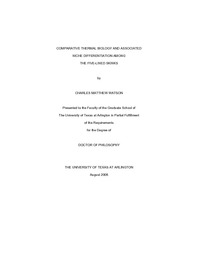
ATTENTION: The works hosted here are being migrated to a new repository that will consolidate resources, improve discoverability, and better show UTA's research impact on the global community. We will update authors as the migration progresses. Please see MavMatrix for more information.
Show simple item record
| dc.contributor.author | Watson, Charles Matthew | en_US |
| dc.date.accessioned | 2008-09-17T23:35:10Z | |
| dc.date.available | 2008-09-17T23:35:10Z | |
| dc.date.issued | 2008-09-17T23:35:10Z | |
| dc.date.submitted | August 2008 | en_US |
| dc.identifier.other | DISS-2229 | en_US |
| dc.identifier.uri | http://hdl.handle.net/10106/1114 | |
| dc.description.abstract | Three species of five-lined skinks (Plestiodon fasciatus, P. laticeps, and P. inexpectatus) occur in regional sympatry across much of the Southeastern United States. These closely-related species, at one or more levels of development, all exhibit a like phenotype and a high amount of prey resource overlap as documented by published data. Under competitive exclusion hypotheses, these species should therefore not locally co-occur. This study confirms, through analysis of habitat type and canopy cover at the point of capture, that P. inexpectatus and P. fasciatus do not typically inhabit the same forest habitat. In fact, where their ranges overlap, P. fasciatus inhabits closed-canopy hardwood forests, while P. inexpectatus inhabits open forested habitats such as longleaf pine savannah and coastal scrub forests. P. laticeps is routinely found in sympatry with either species. Due to their large adult size, P. laticeps may be able to utilize larger prey, thereby partitioning available resources. Physiological data - oxygen consumption (VO2) and its temperature response (Q10) - supports the hypothesis that these species differ with respect to their metabolic response to temperature. P. fasciatus exhibits a high Q10 at the interval that exceeds the mean daily summer temperature of sampled closed canopy forests (~25°C). P. inexpectatus exhibits a dramatic decrease in metabolic rate on the interval that falls below the mean daily summer temperatures of sampled Longleaf Pine Savannah habitat. The VO2 of P. laticeps is the least temperature sensitive. The specific dynamic action (SDA) and SDA coefficient were also measured and supports the hypothesis that P. fasciatus is physiologically better suited for cooler, closed-canopy habitats while P. inexpectatus is physiologically suited for warmer, open-canopy habitats. Collectively, these findings indicate that an evolutionarily conserved physiological niche among species/populations may play an important role in spatial resource partitioning and maintenance of biodiversity between two of these three closely-related species. | en_US |
| dc.description.sponsorship | Gough, Laura | en_US |
| dc.language.iso | EN | en_US |
| dc.publisher | Biology | en_US |
| dc.title | Comparative Thermal Biology And Associated Niche Differentiation Among the Five-Lined Skinks | en_US |
| dc.type | Ph.D. | en_US |
| dc.contributor.committeeChair | Gough, Laura | en_US |
| dc.degree.department | Biology | en_US |
| dc.degree.discipline | Biology | en_US |
| dc.degree.grantor | University of Texas at Arlington | en_US |
| dc.degree.level | doctoral | en_US |
| dc.degree.name | Ph.D. | en_US |
| dc.identifier.externalLink | https://www.uta.edu/ra/real/editprofile.php?onlyview=1&pid=83 | |
| dc.identifier.externalLinkDescription | Link to Research Profiles | |
Files in this item
- Name:
- umi-uta-2229.pdf
- Size:
- 1.024Mb
- Format:
- PDF
This item appears in the following Collection(s)
Show simple item record


